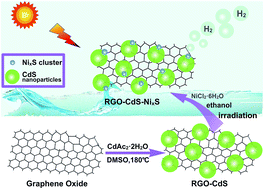Enhanced visible-light-driven hydrogen generation by in situ formed photocatalyst RGO–CdS–NixS from metal salts and RGO–CdS composites†
Abstract
Artificial photosynthesis for H2 production is regarded as a promising strategy to deal with the future energy crisis and environmental problems. To design highly efficient and low-cost photocatalysts is highly desired. Herein, we develop a novel photocatalyst (RGO)n–CdS–NixS (n = 0–7) in situ made simply from the NiCl2 precursor and (RGO)n–CdS composites at room temperature with enhanced visible-light-driven H2 evolution activity. (RGO)2–CdS–NixS shows the highest activity for H2 production in ethanol aqueous solution with a rate up to 17.5 μmol h−1 mg−1, which is about 36 times higher than that of bare CdS, 23.4 times higher than that in the absence of Ni2+ ((RGO)2–CdS), and 2.43 times higher than that in the absence of the graphene scaffold under the same conditions. UV-vis DRS, emission spectra, BET analysis and electrocatalytic activity as well as elemental mapping images suggest that the Ni2+ salt is well fabricated on (RGO)2–CdS for enhanced photocatalytic performance. Accordingly, other metal-based photocatalysts (RGO)2–CdS–M (M = Co2+, Fe2+ or Mn2+) also exhibit high H2 evolution activity. This study highlights a simple in situ deposition method to fabricate low-cost and highly active photocatalysts for H2 production.

- This article is part of the themed collection: Celebrating Excellence in Research: Women of Materials Science


 Please wait while we load your content...
Please wait while we load your content...